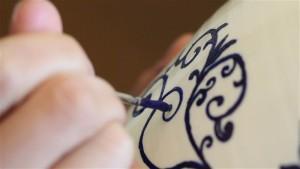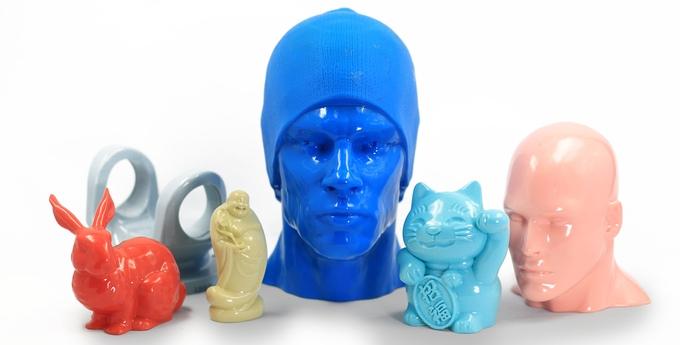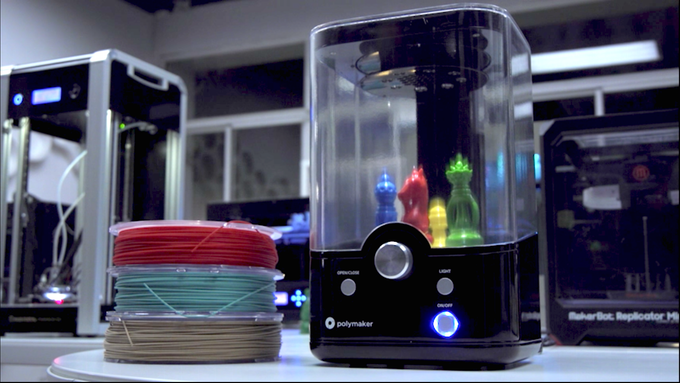When we look at works of art, it’s rare that we consider how many hours—often challenging and painstaking ones—went into making something so exclusive. We are drawn to authentic, handcrafted pieces that someone with a unique talent has poured their creativity into because they we know they were thoughtfully and carefully considered from beginning to end, cared for—and they become something we can perhaps purchase and treasure for years, or even hand down to future generations.
The picture of the artisan hand painting crafts in the studio stands in stark contrast to millions of completely identical and perfectly formed items being replicated in factories, rolling off the lines and headed to retail shops for branding with yellow price tags. The artist’s spirit, in all its magic, is generally a curious one too though, and when newer technologies like 3D printing and myriad accompanying materials present themselves, it’s undeniably exciting to use them as tools and employ in juxtaposition with an older style—even ancient—and somehow purer. New technology sometimes also has a way of offering new aesthetics—and fixing age-old inconveniences and issues at the same time. There’s no shame in that!
Also in contrast, when we see a 3D printed item, the first question we do have is regarding how long it took to make and then finish. The mode of manufacturing and the technicalities are more on our mind, often, than absorbing the aesthetics. And depending on the complexity of the 3D printed design, most likely it was fabricated much faster than something handmade, finishing processes notwithstanding.
 For artist Tian Tian, the joy is found in detailed painting, as she creates intricate designs on Qing Dynasty style vases. It takes her two to three days of steady work to complete one of her vases, sometimes adding up to as much as 32 hours. This type of craftsmanship was begun in the 13th century in China and requires skill and an obviously very steady hand—as well as a smooth surface to accommodate the fine brush strokes.
For artist Tian Tian, the joy is found in detailed painting, as she creates intricate designs on Qing Dynasty style vases. It takes her two to three days of steady work to complete one of her vases, sometimes adding up to as much as 32 hours. This type of craftsmanship was begun in the 13th century in China and requires skill and an obviously very steady hand—as well as a smooth surface to accommodate the fine brush strokes.
While her hands may bear the talent brought forth from ancient ancestors who once crafted the detailed blue patterns—Tian’s use of 3D printed vases is certainly a new twist—but that’s not all. The Director of Digital Media Art Design at Aurora College, Shanghai, was part of a recent case study in using Polymaker’s latest offerings, PolySmooth material and their extremely cool new ‘polishing’ machine, the Polysher, for producing vases with a smooth, glossed finish that just invites the paintbrush to glide over it with ease.
The elegant looking Polysher machine centers around a nebulizer spraying alcohol into the chamber, filling it, and ultimately ‘glossing’ the 3D model, smoothing nearly all layer marks away. The users will find it very easy to operate too, as this is all that’s involved:
- 3D print your part with PolySmooth, just like what you normally do with PLA.
- Place the printed part in the Polysher.
- Set the polishing time by turning the knob, expecting a typical part to take up to 40 minutes, depending on the size and environmental temperature.
- Once polishing is finished, the stage will automatically lift up, and you can remove the part.
While artists like Tian might have an easier time painting on 3D printed items now, they’ve just found a way to have a whole lot more fun as well—with no time-consuming sanding involved.
“PolySmooth creates the perfect surface for high details painting,” said Tian. “Furthermore, with 3D printing I can explore new designs and vase geometries bringing this traditional art into the twenty-first century.”
The layered effect associated with 3D printing can indeed make finishing difficult, and especially if you are painting in great detail on the finished product. We’ve been following Polymaker since the recent release of the PolySmooth Material, coupled with the Polysher machine, quite fascinated too with this high-tech duo that is able to give your models what looks like an injection molded surface. It’s further interesting to see the technology paired with a specific artist who finds its benefits quite relevant.
“There are no ups or downs anymore,” says Tian of the material and Polysher. “This makes the paint flow coherently and fluently. No stops anymore. What’s more, the thickness remains the same easily.”
“I think it’s a useful carrier of traditional Chinese art.”
The artist appreciates 3D printing in her art as she enjoys some of the greatest benefits many around the world are too, as she is able to work as a self-sustained unit, fabricating exactly what she wants, affordably and quickly, and applying customizations at will. And with the polishability of PolySmooth and the mechanics of the Polysher, she’s ensured of a process that’s much more enjoyable.
The material, available in 11 colors, has basically been taken as far as it can go in terms of one that produces as little striation marks as possible, which is what makes the need for a polishing machine such as the Polysher. Polymaker has also, as planned, launched both the PolySmooth and Polysher on Kickstarter with hopes of raising $100,000 by May 25th.
The campaign is already meeting with astounding results from backers, well over double its goal at the time of this writing. This is one of those instances where you better get in quick if you are looking for that Kickstarter discount, with Polysher machines still available at $249 (that includes one free spool of PolySmooth too). Delivery is estimated to begin in October.
If you want to shell out the big bucks, you can also back the Polysher by purchasing your very own mini-factory for just under $1800, receiving a volume of machines and materials. The true high rollers can pledge their $10K and fly all the way to Shanghai to meet the Polymaker team in person, have a tour of their facilities, and receive a special-edition Polysher, plus materials.
Poor surface quality may truly become a thing of the past—especially considering the number of people out there racing to buy a product like the Polysher. Designers can gleefully toss out that sandpaper and say goodbye to ‘bumps.’ And whether you have an artistic flair or not, just watching the materials, machine, and an artist like Tian in action is enough to make one want to take up painting just to feel the smooth glide of the brush on one of those glossy surfaces. Is this a double whammy of technology you’d like to try? Discuss in the PolySmooth & Polysher to Smooth Out 3D Prints forum over at 3DPB.com.
Subscribe to Our Email Newsletter
Stay up-to-date on all the latest news from the 3D printing industry and receive information and offers from third party vendors.
Print Services
Upload your 3D Models and get them printed quickly and efficiently.
You May Also Like
Consolidation in AM: How 2025 Is Shaping the Industry’s New Normal
The first half of 2025 has been marked by a clear shift in the additive manufacturing (AM) industry. Companies are no longer just focused on developing new tech by themselves....
Etsy Design Rule Change Reduces Selection of 3D Printed Goods
Online marketplace Etsy has implemented a rule change requiring all 3D printed goods on the site to be original designs. The update to the site’s Creativity Standards states, ¨Items produced using...
U.S. Congress Calls Out 3D Printing in Proposal for Commercial Reserve Manufacturing Network
Last week, the U.S. House of Representatives’ Appropriations Committee moved the FY 2026 defense bill forward to the House floor. Included in the legislation is a $131 million proposal for...
Transforming From Tourist to Native: Duro CEO Michael Corr Explains Why the Company Rebuilt its PLM Software on AI
In these early innings of the AI boom, many market analysts have expressed concern that AI spend has gotten too far ahead of the technology’s proven ability to deliver significant...


































